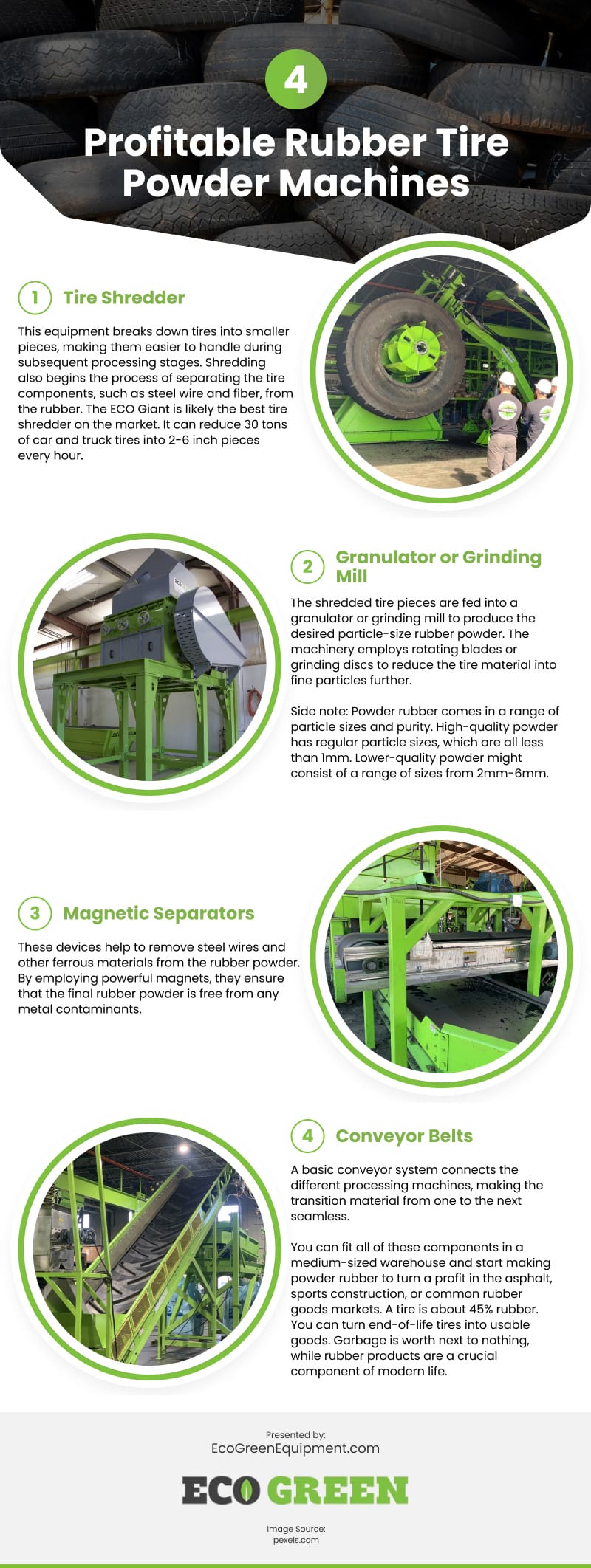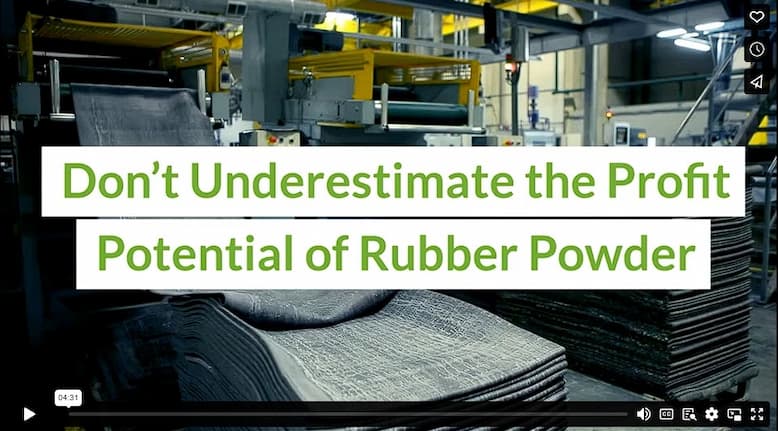There are advertisements galore for protein powder. Average bodies transformed as if by magic into shapes more like Greek gods. We all know the smell of freshly baked blueberry muffins, crispy on top, mushrooming out of the holders, thanks partly to the magic of baking powder. More of an adventure type? Maybe you’re a skier. If so, the best days, the ones you dream about all summer long, are filled with one magic ingredient: powder.
Why do tire recyclers care about powder?
In tire recycling, powder is an end product of tire processing. In this case, the powder is made from rubber by grinding and crushing tires. The nylon and steel are separated out, and the final product looks like fine, black volcanic sand. And, just like the various types of powders mentioned above, powder rubber has unique properties that makes it both useful to many businesses and a lucrative end product for your tire recycling plant.
Versatile Uses of Rubber Powder:
- Asphalt Modification: Adding rubber powder to asphalt mixtures enhances performance. It improves elasticity, reduces cracking, and increases its resistance to temperature variations. This application finds extensive use in road construction, resulting in more durable and long-lasting road surfaces. It can also make asphalt more forgiving in a motorcycle accident, trip, or fall.
- Sports Surfaces: Rubber powder is also a component of artificial turf and rubberized playground surfaces. The rubber enables these surfaces to offer better shock absorption, reducing the risk of injuries during sports activities. Rubber powder’s resilience and weather resistance make it an ideal choice for outdoor recreational areas. And while some people may worry about the toxins in car tires harming children, there is no scientific evidence that powder rubber surfaces pose any health threat.
- Manufacturing of Rubber Products: Rubber powder is a valuable raw material in producing rubber-based goods. Manufacturers commonly use it to manufacture rubber mats, gaskets, seals, and flooring materials. The production of these wide-ranging goods with tire rubber reduces our dependency on virgin rubber and promotes a more sustainable approach to manufacturing.
What machinery do you need to turn tires into powder?
The answer is less complicated than you might imagine. Recycling machinery engineers, like those at ECO Green, have designed tire crushers and other tire powder machines that make the process automated and fast. The machinery typically consists of the following components:
1. Tire Shredder
This equipment breaks down tires into smaller pieces, making them easier to handle during subsequent processing stages. Shredding also begins the process of separating the tire components, such as steel wire and fiber, from the rubber. The ECO Giant is likely the best tire shredder on the market. It can reduce 30 tons of car and truck tires into 2-6 inch pieces every hour.
2. Granulator or Grinding Mill
The shredded tire pieces are fed into a granulator or grinding mill to produce the desired particle-size rubber powder. The machinery employs rotating blades or grinding discs to reduce the tire material into fine particles further.
Side note: Powder rubber comes in a range of particle sizes and purity. High-quality powder has regular particle sizes, which are all less than 1mm. Lower-quality powder might consist of a range of sizes from 2mm-6mm. The higher quality powder also is more completely cleansed of unwanted particles, including tire wire and fibers.
3. Magnetic Separators
These devices help to remove steel wires and other ferrous materials from the rubber powder. By employing powerful magnets, they ensure that the final rubber powder is free from any metal contaminants.
4. Conveyor Belts
A basic conveyor system connects the different processing machines, making the transition material from one to the next seamless.
You can fit all of these components in a medium-sized warehouse and start making powder rubber to turn a profit in the asphalt, sports construction, or common rubber goods markets. A tire is about 45% rubber. You can turn end-of-life tires into usable goods. Garbage is worth next to nothing, while rubber products are a crucial component of modern life.
Refining your process to create high-quality powder gives you more bargaining power when negotiating a selling price. You will want to invest in tire-specific shredders and granulators to make the most quality powder. While there are many general crumbing machines around, many of these will become clogged or fail to separate the rubber from other tire components.
Amidst the potential end products of recycled tires, rubber powder remains an unsung hero used in many products and processes. But, it may well be the key to making a profit as a tire recycler. Talk to businesses around you to determine how lucrative the rubber powder market could be.
Infographic
Tire recycling involves the production of powder as an end product of tire processing. The powder is made by crushing and grinding rubber tires. Recycling machinery engineers have designed tire crushers and other tire powder machines that make the process automated and fast. Check out this infographic to learn about the machinery needed to turn tires into powder.

Video





